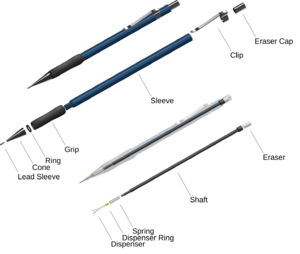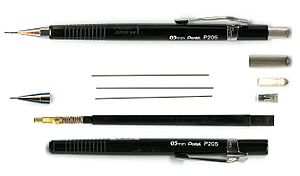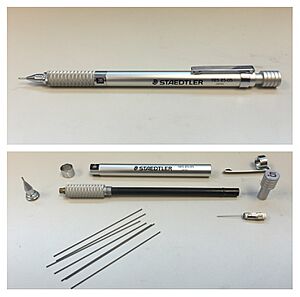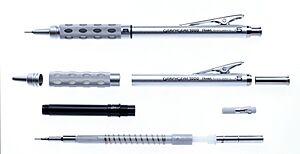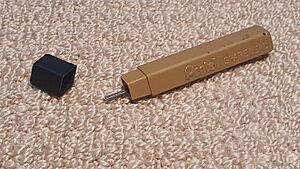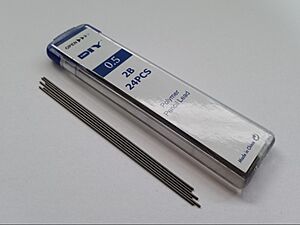Mechanical pencil facts for kids
A mechanical pencil is a special kind of pencil that holds a solid stick of "lead" (which is actually graphite, not the metal lead!). Unlike regular pencils, you don't need to sharpen a mechanical pencil. Instead, you can make the lead stick out more as you use it. Most mechanical pencils also have erasers on them.
People call mechanical pencils by many names, like automatic pencil, drafting pencil, or propelling pencil. They are great for drawing exact lines, like in technical drawing, or for neat writing. Artists also use them for detailed drawings. Since you don't have to sharpen them, students often like them too! Mechanical pencils have been around since the 1700s, and many new designs came out in the 1800s and 1900s.
Contents
History of Mechanical Pencils
The idea of a pencil that holds its lead isn't new. Someone named Conrad Gessner described a lead holder way back in 1565. However, with his design, you still had to adjust the lead by hand to make it sharp.
The oldest mechanical pencil we've found that has a date was discovered on a sunken ship called HMS Pandora. This ship sank in 1791.
The first official patent for a refillable pencil that could push its lead forward was given to Sampson Mordan and John Isaac Hawkins in Britain in 1822. Sampson Mordan later bought out Hawkins's rights and started his own company. His company made pencils and other silver items until World War II, when their factory was bombed.
Between 1822 and 1874, over 160 patents were filed for new ideas to make mechanical pencils better. The first pencil that used a spring to push the lead was patented in 1877. Over time, the size of the lead changed. Early pencils often used thicker leads, but thinner ones became popular later, like 0.7 mm, which is common today.
The first truly modern mechanical pencil was called the Eversharp. It was invented by Charles R. Keeran, who got the main patent in 1913. This pencil was special because it was simple to use, could hold a lot of lead, and was comfortable to hold. It became so popular that "Eversharp" was often used as a general name for any mechanical pencil. By the early 1920s, over 12 million Eversharp pencils had been sold!
In Japan, a metalworker named Tokuji Hayakawa invented a pioneering mechanical pencil in 1915. He patented it in Japan in 1920 and called it the "Ever-Ready Sharp Pencil." Sadly, his factory was destroyed in the Great Kantō earthquake in 1923. Tokuji Hayakawa later started making radios, but his first invention is remembered in the name of his company: Sharp.
Who Makes Mechanical Pencils?
Many companies around the world make mechanical pencils today. Some well-known ones include:
- Pentel, Pilot, Tombow, Uni-ball and Zebra from Japan.
- Faber-Castell, Lamy, Rotring and Staedtler from Germany.
- Koh-i-Noor Hardtmuth from the Czech Republic.
- Bic from France.
- Monami from South Korea.
- PaperMate and Parker from the USA.
- Caran d'Ache from Switzerland.
There are also many other manufacturers in Asia and Europe.
How Mechanical Pencils Work
Mechanical pencils generally come in two main types:
- Those that can push the lead forward.
- Those that just hold the lead in place.
Screw-Based Pencils
Older mechanical pencils often used a screw system. You would twist a part of the pencil, and a pin or carrier would move the lead down the pencil barrel. You usually had to put new lead in from the front. Most of these pencils could also pull the lead back in by twisting the other way, but some older ones required you to push the lead back by hand.
Clutch Pencils (Leadholders)
A clutch pencil, also called a leadholder, usually uses thicker leads (from 2.0 mm to 5.6 mm). It typically holds only one piece of lead at a time. To use it, you press the eraser cap on top. This opens small "jaws" inside the tip, allowing the lead to fall freely out (or back in). Because the lead falls freely, you control how much comes out by holding the pencil tip a few millimeters above your paper or hand. Some clutch pencils can advance the lead a little bit at a time, but they are different from most propelling pencils.
Ratchet-Based Pencils
Ratchet-based pencils are also known as "repeater" pencils. In these, the lead is held by two or three small jaws inside the tip. A button, usually on the end or side of the pencil, controls these jaws. When you push the button, the jaws move forward and open, letting the lead move out. When you let go of the button, the jaws pull back, and a small rubber part inside the tip holds the lead in place. This stops the lead from falling out or sliding back into the pencil until the jaws grip it again.
Some ratchet pencils let you shake the pencil back and forth to make the lead advance. A weight inside the pencil moves a mechanism in the cap. These pencils might also have a button if you want to advance the lead by hand.
An advanced type of ratchet pencil can even rotate the lead! Every time you press the lead onto the paper (which counts as one stroke), the pencil rotates the lead a little bit (like 9 degrees). This helps the lead wear down evenly, keeping your lines consistently thin. This "auto-rotation" system was first developed by Schmidt in Germany and later improved by Mitsubishi Pencil Company in Japan, who called it Kuru Toga. This type of pencil is very useful for writing in languages that have many strokes per letter, where you lift the pencil often.
There are also special protection systems that stop the lead from breaking if you press too hard. For example, the DelGuard system by Zebra in Japan makes the lead sleeve extend out if you press too hard at an angle. If you press too hard straight down, the lead automatically pulls back inside.
Many higher-quality mechanical pencils have a lead hardness grade indicator. Some also have a retractable lead guide pipe. This means the metal tip that guides the lead can slide back into the pencil body. This protects the tip when you're not using it and makes the pencil safe to carry in your pocket.
Lead Types and Sizes

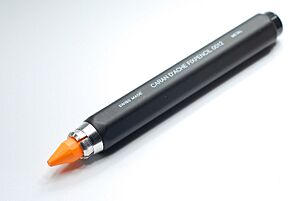
Even though they are called "pencil leads," they don't contain the toxic metal lead. Instead, they are usually made from graphite and clay, or sometimes plastic materials. Regular wooden pencils have lead that is glued to the wood, which makes it stronger. Mechanical pencil leads used to be weaker, but in 1962, Pentel introduced new leads made with polymers. These polymers act like a glue, making the leads much stronger and allowing manufacturers to make them in smaller sizes.
Most mechanical pencils can be refilled, but some cheaper ones are made to be thrown away once the lead runs out.
Lead Diameter
Mechanical pencils are designed to use only one specific lead diameter. However, some pencils, like the Pentel Function 357, can hold several mechanisms in one body, letting you use different lead thicknesses (like 0.3, 0.5, and 0.7 mm).
Different lead sizes are available for various needs. The most common sizes are 0.5 mm and 0.7 mm. These sizes offer a good balance between being precise and being strong enough not to break easily. Less common sizes range from very thin (0.2 mm) to very thick (5.6 mm). Pentel even showed a test version of a 0.1 mm pencil once!
Pencils that use leads thinner than 1 mm can usually hold many leads at once, so you don't have to refill them as often. You can buy refill leads in small tubes and put them into your pencil when you need them.
Here are some common lead diameters and what they are used for:
| Diameter (mm) |
Uses |
|---|---|
| 0.20 | For very detailed technical work |
| 0.30 | For technical work (sometimes called 0.35 mm) |
| 0.40 | For technical work (mostly in Japan & South Korea) |
| 0.50 | Good for general writing and technical drawings |
| 0.60 | For general writing (mostly in Japan, no longer made by Tombow) |
| 0.70 | Good for general writing |
| 0.80 | For general writing |
| 0.90 | Popular for students and general writing (sometimes called 1.0 mm) |
| 1.30 | Used by brands like Staedtler and Pentel (Pentel only for color leads) |
| 1.40 | Used in some Faber-Castell and Lamy pencils, and kids' pencils |
| 2.00 | Common for drafting leadholders |
| 3.15 | For non-drafting leadholders |
| 5.60 | For non-drafting uses |
It's important to know that the listed diameters are not always exact. For example, a "0.5 mm" lead might actually be slightly larger, like 0.55 mm to 0.58 mm, according to Japanese standards.
Lead Length
For leads thinner than 1 mm, the standard length of the lead stick is 60 mm. However, some companies make leads that are 75 mm long for certain types.
Lead Hardness
Just like regular pencils, mechanical pencil leads come in different levels of hardness. This affects how dark your writing or drawing will be and how long the lead lasts. A common mechanical pencil lead is similar to an HB (or US#2) pencil lead. The hardness depends on how much polymer (or resin) and graphite are in the lead.
Lead hardness is measured on a scale:
- H stands for hardness. These leads are harder and make lighter, gray lines.
- B stands for blackness. These leads are softer and make darker lines.
- F stands for fine. This is in between H and HB on the scale.
While standard wooden pencils have many different hardness grades, mechanical pencil leads usually come in about 10 grades, from 4H (very hard) to 4B (very soft).
Colored Leads
Mechanical pencils can also use colored leads, though they are not as common. Some companies like Crayola make "Twistable" colored pencils that work like mechanical pencils, but they don't offer refills. However, companies like Pentel, Pilot, and Uni-ball do make colored refill leads in certain sizes (like 0.5 mm, 0.7 mm, or 2.0 mm) for their pencils. You can also find "variety packs" with different colors. Koh-i-Noor makes mechanical colored pencils with refillable leads in 2.0, 3.15, and 5.6 mm sizes.
See also
- Technical drawing tools


